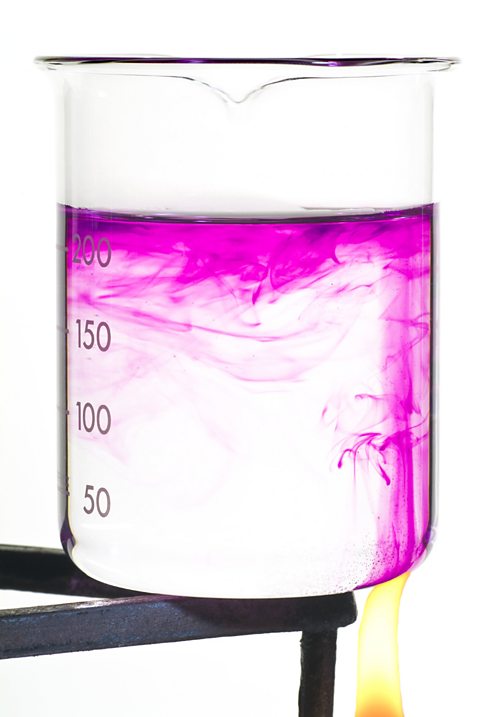Convection
Heat can be transferred in liquids or gases by convectionThe transfer of heat energy through a moving liquid or gas..
Fluids
Liquids and gases are fluids because they can be made to flow.
The particleA general term for a small piece of matter. For example, protons, neutrons, electrons, atoms, ions or molecules. in these fluids can move from place to place.
Convection occurs when particles with a lot of heat energy in a liquid or gas move and take the place of particles with less heat energy.
Convection in a liquid
Convection in a liquid can be seen by putting a crystal of potassium permanganate in a beaker of water and gently heating it with a Bunsen flame.

- Heat is initially transferred through the glass wall of the beaker by conductionThe transfer of heat through a material by transferring kinetic energy from one particle to another..
- The water in the region of the Bunsen flame is heated.
- It expands, becomes less dense and rises.
- It is replaced by the cooler, denser water which surrounds it.
- This water is in turn heated, expands becomes less dense and rises.
- The process continues, a convection current is set up and heat is transferred through the liquid.
Convection currents can be seen in lava lamps.
The wax inside the lamp warms up, becomes less dense than the liquid and so rises.
Convection in a gas
- Air close to the radiator is heated.
- It expands, becomes less dense and rises.
- It is replaced by the cooler, denser air which surrounds it.
- This air is in turn heated, expands becomes less dense and rises.
- The process continues, a convection current is set up and heat is transferred through the air and hence through the room.
Convection currents enable hot air balloons to rise, and also explain why it is often hotter in houses upstairs rather than downstairs.
Most of our winds are caused by convection currents occurring on a big scale in air.
Many ocean currents are also due to convection currents.